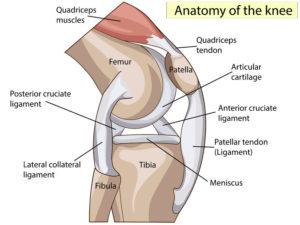 Recently patellar tendon injuries have been in the news. What is the patellar tendon? What does it do? And what is the problem with a patellar tendon tear? Let’s take a look…
Recently patellar tendon injuries have been in the news. What is the patellar tendon? What does it do? And what is the problem with a patellar tendon tear? Let’s take a look…
What is a patellar tendon and what does it do?
The patellar tendon runs from your kneecap (patella) to the top and front of your shin bone, usually at a bump called the tibial tubercle. Since it essentially runs from a bone to a bone, some refer to it as a ligament. But it really is a continuation of your quadriceps tendon with a chunk of bone (your knee cap) embedded in it. It’s this anatomical fact that defines the patellar tendon’s function. I’ll explain…
The Quadricep’s is the large muscle group that makes up your thigh. It is responsible for extending (straightening) your knee and kicking out. It works by “pulling” on the patellar tendon and moving your lower leg. Much of the power of this action comes because the kneecap displaces the tendon away from the joint. A little physics: Torque is the force with which something rotates around an axis – A wrench working on a bolt. Torque strength equals force x distance from the point of rotation. By moving your quadriceps tendon away from the joint, the patella allows for significantly increased strength of your knee extension.
All of this works because your quadriceps tendon, through the patellar tendon, ultimately attaches to your tibia. If it didn’t, not only would the strength of your kick be weakened, but just walking without assistance would be impossible.
What is a patellar tendon tear?
When the patellar tendon tears, it usually pulls off the bottom of your kneecap. It can tear in its midsubstance or off your shin bone but these types of tears are uncommon.
Patellar tendon tears occur when the force of pull on the tendon supersedes its strength of attachment. This frequently occurs with running, jumping and most often when landing following a jump. Particularly if the tendon attachment is weakened as occurs with age or chronic over usage.
Watch this video to see how NFL Houston Texan’s offensive lineman Derek Newton tears his left patellar tendon
What are the common patellar tendon tear symptoms?
You will know if you completely tear your patellar tendon. There will be acute pain in the front of your knee. You will be unable to actively straighten your leg or walk without collapsing. Additionally, your knee will look odd. Most often the patella will be pulled upward by your quadriceps. Because of this as well as the torn tendon, the appearance of your knee will be different than usual. The typical flat surface of the front of your kneecap will not be there. If you bend your knee, you may see the hilly appearance of the front end of your femur bone. In time, you will develop swelling and stiffness. The front of your knee may also turn black and blue.
What should you do if you tear your patellar tendon?
In all but the very ill or those who do not walk, a patellar tendon tear will require surgery. It is not an emergency but performing the surgery sooner, within days or a few weeks at the most, gives the best chance of a good outcome. So if you believe that you have torn your patellar tendon, seek medical care promptly. Not only can they confirm the diagnosis, but they can also make sure no other significant injury has occurred, help you with your pain and provide a brace and crutches that will enable you to walk.
How Is patellar tendon tear surgery performed?
Surgery for a patellar tendon tear is relatively straightforward. In healthy people, it can be performed as an outpatient procedure. The tendon is simply reattached to the bottom of your patella through an incision in the front of your knee. This is done with various techniques using sutures (small surgical strings). Often adjacent tissues are torn which are repaired similarly.
Over time the tendon will heal to the patella. Until then it is held in place by the sutures. Because these can fray or pull out of the tendon, early knee motion and other activities are often limited. I will often place a “protection” suture around the top of the patella and through a tunnel made in the top of the shin bone. This allows earlier motion with less concern for suture failure.
What is the recovery like after patellar tendon tear surgery?
Your knee will almost always be placed in a protective brace. This often will enable you to walk very shortly after surgery and can also be set to restrict motion to safe limits.
The tendon will take about 3 months until it heals to the patella. So usually the knee will need some protection until then. Formal physical therapy will be needed for some time. It would be rare to begin jogging before 4-5 months from surgery. Your range of motion will improve for about 6 months and strength, endurance, and coordination for at least a year.
What can I expect after recovering from patellar tendon tear surgery?
It is not uncommon to lose some flexibility in your knee after this injury. Usually, the loss will be in bending the knee. However, most motivated patients can return to their prior activities with time…and a lot of hard work!
